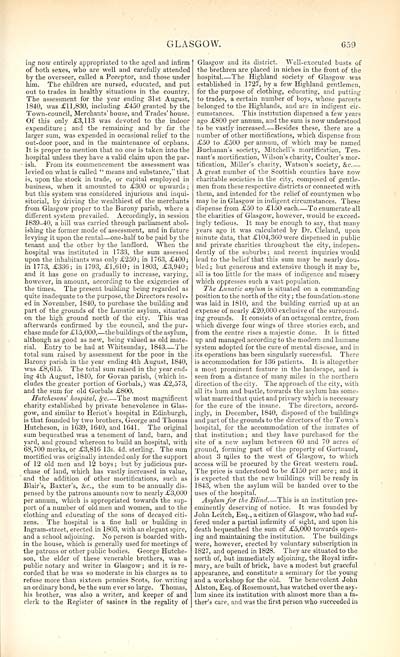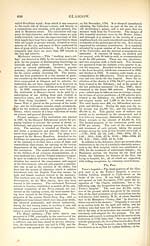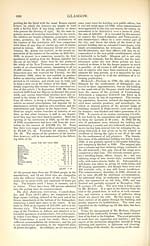Topographical, statistical, and historical gazetteer of Scotland > Volume 1
(757) Page 659
Download files
Complete book:
Individual page:
Thumbnail gallery: Grid view | List view

GLASGOW.
G59
ing now entirely appropriated to the aged and infirm
of both sexes, who are well and carefully attended
by the overseer, called a Peceptor, and those under
him. The children are nursed, educated, and put
out to trades in healthy situations in the country.
The assessment for the year ending 31st August,
1840, was £11,830, including £450 granted by the
Town-council, Merchants' house, and Trades' house.
Of this only £3,113 was devoted to the indoor
expenditure ; and the remaining and by far the
larger sum, was expended in occasional relief to the
out-door poor, and in the maintenance of orphans.
It is proper to mention that no one is taken into the
hospital unless they have a valid claim upon the par-
■ ish. From its commencement the assessment was
levied on what is called " means and substance," that
is, upon the stock in trade, or capital employed in
business, when it amounted to £300 or upwards ;
but this system was considered injurious and inqui-
sitorial, by driving the wealthiest of the merchants
from Glasgow proper to the Barony parish, where a
different system prevailed. Accordingly, in session
1839-40, a bill was carried through parliament abol-
ishing the former mode of assessment, and in future
levying it upon the rental — one-half to be paid by the
tenant and the other by the landlord. When the
hospital was instituted in 1733, the sum assessed
upon the inhabitants was onlv£250; in 1763, £400;
in 1773, £336; in 1793, £1,610; in 1803, £3,940;
and it has gone on gradually to increase, varying,
however, in amount, according to the exigencies of
the times. The present building being regarded as
quite inadequate to the purpose, the Directors resolv-
ed in November, 1840, to purchase the building and
part of the grounds of the Lunatic asylum, situated
on the high ground north of the city. This was
afterwards confirmed by the council, and the pur-
chase made for £15,000, — the buildings of the asylum,
although as good as new, being valued as old mate-
rial. Entry to be had at Whitsunday, 1843 The
total sum raised by assessment for the poor in the
Barony parish in the year ending 4th August, 1840,
was £8,615. The total sum raised in the year end-
ing 4th August, 1840, for Govan parish, (which in-
cludes the greater portion of Gorbals,) was £2,573,
and the sum for old Gorbals £800.
Hutchesons' hospital, 8fc The most magnificent
charity established by private benevolence in Glas-
gow, and similar to Heriot's hospital in Edinburgh,
is that founded by two brothers, George and Thomas
Hutcheson, in 1639, 1640, and 1641. The original
sum bequeathed was a tenement of land, barn, and
yard, and ground whereon to build an hospital, with
68,700 merks, or £3,816 13s. 4d. sterling. The sum
mortified was originally intended only for the support
of 12 old men and 12 boys; but by judicious pur-
chase of land, which has vastly increased in value,
and the addition of other mortifications, such as
Blair's, Baxter's, &c, the sum to be annually dis-
pensed by the patrons amounts now to nearly £3,000
per annum, which is appropriated towards the sup-
port of a number of old men and women, and to the
clothing and educating of the sons of decayed citi-
zens. The hospital is a fine hall or building in
Ingram-street, erected in 1803, with an elegant spire,
and a school adjoining. No person is boarded with-
in the house, which is generally used for meetings of
the patrons or other public bodies. George Hutche-
son, the elder of these venerable brothers, was a
public notary and writer in Glasgow ; and it is re-
corded that he was so moderate in his charges as to
refuse more than sixteen pennies Scots, for writing
an ordinary bond, be the sum ever so large. Thomas,
his brother, was also a writer, and keeper of and
clerk to the Register of sasines in the regality of
Glasgow and its district. Well-executed busts of
the brethren are placed in niches in the front of the
hospital. — The Highland society of Glasgow was
established in 1727, by a few Highland gentlemen,
for the purpose of clothing, educating, and putting
to trades, a certain number of boys, whose parents
belonged to the Highlands, and are in indigent cir-
cumstances. This institution dispensed a few years
ago £800 per annum, and the sum is now understood
to be vastly increased Besides these, there are a
number of other mortifications, which dispense from
£50 to £500 per annum, of which may be named
Buchanan's society, Mitchell's mortification, Ten-
nant's mortification, Wilson's charity, Coulter's mor-
tification, Miller's charity, Watson's society, &c
A great number of the Scottish counties have now
charitable societies in the city, composed of gentle-
men from these respective districts or connected with
them, and intended for the relief of countymen who
may be in Glasgow in indigent circumstances. These
dispense from £50 to £150 each. — To enumerate all
the charities of Glasgow, however, would be exceed-
ingly tedious. It may be enough to say, that many
years ago it was calculated by Dr. Cleland, upon
minute data, that £104,360 were dispensed in public
and private charities throughout the city, indepen-
dently of the suburbs; and recent inquiries would
lead to the belief that this sum may be nearly dou-
bled ; but generous and extensive though it may be,
all is too little for the mass of indigence and misery
which oppresses such a vast population.
The Lunatic asylum is situated on a commanding
position to the north of the city ; the foundation-stone
was laid in 1810, and the building carried up at an
expense of nearly £20,000 exclusive of the surround-
ing grounds. It consists of an octagonal centre, from
which diverge four wings of three stories each, and
from the centre rises a majestic dome. It is fitted
up and managed according to the modern and humane
system adopted for the cure of mental disease, and in
its operations has been singularly successful. There
is accommodation for 136 patients. It is altogether
a most prominent feature in the landscape, and is
seen from a distance of many miles in the northern
direction of the city. The approach of the city, with
all its hum and bustle, towards the asylum has some-
what marred that quiet and privacy which is necessary
for the cure of the insane. The directors, accord-
ingly, in December, 1840, disposed of the buildings
and part of the grounds to the directors of the Town's
hospital, for the accommodation of the inmates of
that institution ; and they have purchased for the
site of a new asylum between 60 and 70 acres of
ground, forming part of the property of Gartnaud,
about 3 miles to the west of Glasgow, to which
access will be procured by the Great western road.
The price is understood to be £150 per acre ; and it
is expected that the new buildings will be ready in
1843, when the asylum will be handed over to the
uses of the hospital.
Asylum for the Blind This is an institution pre-
eminently deserving of notice. It was founded by
John Leitch, Esq., a citizen of Glasgow, who had suf-
fered under a partial infirmity of sight, and upon his
death bequeathed the sum of £5,000 towards open-
ing and maintaining the institution. The buildings
were, however, erected by voluntary subscription in
1827, and opened in 1828. They are situated to the
north of, but immediately adjoining, the Royal infir-
mary, are built of brick, have a modest but graceful
appearance, and constitute a seminary for the young
and a workshop for the old. The benevolent John
Alston, Esq. of Rosemount, has watched over the asy-
lum since its institution with almost more than a fa-
ther's care, and was the first person who succeeded in
G59
ing now entirely appropriated to the aged and infirm
of both sexes, who are well and carefully attended
by the overseer, called a Peceptor, and those under
him. The children are nursed, educated, and put
out to trades in healthy situations in the country.
The assessment for the year ending 31st August,
1840, was £11,830, including £450 granted by the
Town-council, Merchants' house, and Trades' house.
Of this only £3,113 was devoted to the indoor
expenditure ; and the remaining and by far the
larger sum, was expended in occasional relief to the
out-door poor, and in the maintenance of orphans.
It is proper to mention that no one is taken into the
hospital unless they have a valid claim upon the par-
■ ish. From its commencement the assessment was
levied on what is called " means and substance," that
is, upon the stock in trade, or capital employed in
business, when it amounted to £300 or upwards ;
but this system was considered injurious and inqui-
sitorial, by driving the wealthiest of the merchants
from Glasgow proper to the Barony parish, where a
different system prevailed. Accordingly, in session
1839-40, a bill was carried through parliament abol-
ishing the former mode of assessment, and in future
levying it upon the rental — one-half to be paid by the
tenant and the other by the landlord. When the
hospital was instituted in 1733, the sum assessed
upon the inhabitants was onlv£250; in 1763, £400;
in 1773, £336; in 1793, £1,610; in 1803, £3,940;
and it has gone on gradually to increase, varying,
however, in amount, according to the exigencies of
the times. The present building being regarded as
quite inadequate to the purpose, the Directors resolv-
ed in November, 1840, to purchase the building and
part of the grounds of the Lunatic asylum, situated
on the high ground north of the city. This was
afterwards confirmed by the council, and the pur-
chase made for £15,000, — the buildings of the asylum,
although as good as new, being valued as old mate-
rial. Entry to be had at Whitsunday, 1843 The
total sum raised by assessment for the poor in the
Barony parish in the year ending 4th August, 1840,
was £8,615. The total sum raised in the year end-
ing 4th August, 1840, for Govan parish, (which in-
cludes the greater portion of Gorbals,) was £2,573,
and the sum for old Gorbals £800.
Hutchesons' hospital, 8fc The most magnificent
charity established by private benevolence in Glas-
gow, and similar to Heriot's hospital in Edinburgh,
is that founded by two brothers, George and Thomas
Hutcheson, in 1639, 1640, and 1641. The original
sum bequeathed was a tenement of land, barn, and
yard, and ground whereon to build an hospital, with
68,700 merks, or £3,816 13s. 4d. sterling. The sum
mortified was originally intended only for the support
of 12 old men and 12 boys; but by judicious pur-
chase of land, which has vastly increased in value,
and the addition of other mortifications, such as
Blair's, Baxter's, &c, the sum to be annually dis-
pensed by the patrons amounts now to nearly £3,000
per annum, which is appropriated towards the sup-
port of a number of old men and women, and to the
clothing and educating of the sons of decayed citi-
zens. The hospital is a fine hall or building in
Ingram-street, erected in 1803, with an elegant spire,
and a school adjoining. No person is boarded with-
in the house, which is generally used for meetings of
the patrons or other public bodies. George Hutche-
son, the elder of these venerable brothers, was a
public notary and writer in Glasgow ; and it is re-
corded that he was so moderate in his charges as to
refuse more than sixteen pennies Scots, for writing
an ordinary bond, be the sum ever so large. Thomas,
his brother, was also a writer, and keeper of and
clerk to the Register of sasines in the regality of
Glasgow and its district. Well-executed busts of
the brethren are placed in niches in the front of the
hospital. — The Highland society of Glasgow was
established in 1727, by a few Highland gentlemen,
for the purpose of clothing, educating, and putting
to trades, a certain number of boys, whose parents
belonged to the Highlands, and are in indigent cir-
cumstances. This institution dispensed a few years
ago £800 per annum, and the sum is now understood
to be vastly increased Besides these, there are a
number of other mortifications, which dispense from
£50 to £500 per annum, of which may be named
Buchanan's society, Mitchell's mortification, Ten-
nant's mortification, Wilson's charity, Coulter's mor-
tification, Miller's charity, Watson's society, &c
A great number of the Scottish counties have now
charitable societies in the city, composed of gentle-
men from these respective districts or connected with
them, and intended for the relief of countymen who
may be in Glasgow in indigent circumstances. These
dispense from £50 to £150 each. — To enumerate all
the charities of Glasgow, however, would be exceed-
ingly tedious. It may be enough to say, that many
years ago it was calculated by Dr. Cleland, upon
minute data, that £104,360 were dispensed in public
and private charities throughout the city, indepen-
dently of the suburbs; and recent inquiries would
lead to the belief that this sum may be nearly dou-
bled ; but generous and extensive though it may be,
all is too little for the mass of indigence and misery
which oppresses such a vast population.
The Lunatic asylum is situated on a commanding
position to the north of the city ; the foundation-stone
was laid in 1810, and the building carried up at an
expense of nearly £20,000 exclusive of the surround-
ing grounds. It consists of an octagonal centre, from
which diverge four wings of three stories each, and
from the centre rises a majestic dome. It is fitted
up and managed according to the modern and humane
system adopted for the cure of mental disease, and in
its operations has been singularly successful. There
is accommodation for 136 patients. It is altogether
a most prominent feature in the landscape, and is
seen from a distance of many miles in the northern
direction of the city. The approach of the city, with
all its hum and bustle, towards the asylum has some-
what marred that quiet and privacy which is necessary
for the cure of the insane. The directors, accord-
ingly, in December, 1840, disposed of the buildings
and part of the grounds to the directors of the Town's
hospital, for the accommodation of the inmates of
that institution ; and they have purchased for the
site of a new asylum between 60 and 70 acres of
ground, forming part of the property of Gartnaud,
about 3 miles to the west of Glasgow, to which
access will be procured by the Great western road.
The price is understood to be £150 per acre ; and it
is expected that the new buildings will be ready in
1843, when the asylum will be handed over to the
uses of the hospital.
Asylum for the Blind This is an institution pre-
eminently deserving of notice. It was founded by
John Leitch, Esq., a citizen of Glasgow, who had suf-
fered under a partial infirmity of sight, and upon his
death bequeathed the sum of £5,000 towards open-
ing and maintaining the institution. The buildings
were, however, erected by voluntary subscription in
1827, and opened in 1828. They are situated to the
north of, but immediately adjoining, the Royal infir-
mary, are built of brick, have a modest but graceful
appearance, and constitute a seminary for the young
and a workshop for the old. The benevolent John
Alston, Esq. of Rosemount, has watched over the asy-
lum since its institution with almost more than a fa-
ther's care, and was the first person who succeeded in
Set display mode to: Large image | Transcription
Images and transcriptions on this page, including medium image downloads, may be used under the Creative Commons Attribution 4.0 International Licence unless otherwise stated. ![]()
| Gazetteers of Scotland, 1803-1901 > Topographical, statistical, and historical gazetteer of Scotland > Volume 1 > (757) Page 659 |
|---|
| Permanent URL | https://digital.nls.uk/97446630 |
|---|
| Description | Volume first. A-H. |
|---|---|
| Attribution and copyright: |
|

